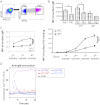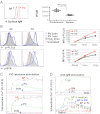Autoantigen can promote progression to a more aggressive TCL1 leukemia by selecting variants with enhanced B-cell receptor signaling
- PMID: 23550156
- PMCID: PMC3631671
- DOI: 10.1073/pnas.1300616110
Autoantigen can promote progression to a more aggressive TCL1 leukemia by selecting variants with enhanced B-cell receptor signaling
Abstract
(Auto)antigen engagement by the B-cell receptor (BCR) and possibly the sites where this occurs influence the outcome of chronic lymphocytic leukemia (CLL). To test if selection for autoreactivity leads to increased aggressiveness and if this selection plays out equally in primary and secondary tissues, we used T-cell leukemia (TCL)1 cells reactive with the autoantigen phosphatidylcholine (PtC). After repeated transfers of splenic lymphocytes from a single mouse with oligoclonal PtC-reactive cells, outgrowth of cells expressing a single IGHV-D-J rearrangement and superior PtC-binding and disease virulence occurred. In secondary tissues, increased PtC-binding correlated with enhanced BCR signaling and cell proliferation, whereas reduced signaling and division of cells from the same clone was documented in cells residing in the bone marrow, blood, and peritoneum, even though cells from the last site had highest surface membrane IgM density. Gene-expression analyses revealed reciprocal changes of genes involved in BCR-, CD40-, and PI3K-signaling between splenic and peritoneal cells. Our results suggest autoantigen-stimulated BCR signaling in secondary tissues promotes selection, expansion, and disease progression by activating pro-oncogenic signaling pathways, and that--outside secondary lymphoid tissues--clonal evolution is retarded by diminished BCR-signaling. This transferrable, antigenic-specific murine B-cell clone (TCL1-192) provides a platform to study the types and sites of antigen-BCR interactions and genetic alterations that result and may have relevance to patients.
Conflict of interest statement
The authors declare no conflict of interest.
Figures





Similar articles
-
B cell receptors in TCL1 transgenic mice resemble those of aggressive, treatment-resistant human chronic lymphocytic leukemia.Proc Natl Acad Sci U S A. 2006 Aug 1;103(31):11713-8. doi: 10.1073/pnas.0604564103. Epub 2006 Jul 24. Proc Natl Acad Sci U S A. 2006. PMID: 16864779 Free PMC article.
-
Two types of BCR interactions are positively selected during leukemia development in the Eμ-TCL1 transgenic mouse model of CLL.Blood. 2015 Mar 5;125(10):1578-88. doi: 10.1182/blood-2014-07-587790. Epub 2015 Jan 6. Blood. 2015. PMID: 25564405 Free PMC article.
-
Accelerated progression of chronic lymphocytic leukemia in Eμ-TCL1 mice expressing catalytically inactive RAG1.Blood. 2013 May 9;121(19):3855-66, S1-16. doi: 10.1182/blood-2012-08-446732. Epub 2013 Mar 15. Blood. 2013. PMID: 23502221 Free PMC article.
-
Lessons learned from the Eµ-TCL1 mouse model of CLL.Semin Hematol. 2024 Jun;61(3):194-200. doi: 10.1053/j.seminhematol.2024.05.002. Epub 2024 May 10. Semin Hematol. 2024. PMID: 38839457 Review.
-
Signaling pathways activated by antigen-receptor engagement in chronic lymphocytic leukemia B-cells.Autoimmun Rev. 2007 Dec;7(2):102-8. doi: 10.1016/j.autrev.2007.02.021. Epub 2007 Mar 28. Autoimmun Rev. 2007. PMID: 18035318 Review.
Cited by
-
BTK inhibition results in impaired CXCR4 chemokine receptor surface expression, signaling and function in chronic lymphocytic leukemia.Leukemia. 2016 Apr;30(4):833-43. doi: 10.1038/leu.2015.316. Epub 2015 Nov 9. Leukemia. 2016. PMID: 26582643 Free PMC article.
-
Inhibition of reactive oxygen species limits expansion of chronic lymphocytic leukemia cells.Leukemia. 2017 Oct;31(10):2273-2276. doi: 10.1038/leu.2017.241. Epub 2017 Jul 28. Leukemia. 2017. PMID: 28751772 No abstract available.
-
A Detailed Analysis of Parameters Supporting the Engraftment and Growth of Chronic Lymphocytic Leukemia Cells in Immune-Deficient Mice.Front Immunol. 2021 Mar 9;12:627020. doi: 10.3389/fimmu.2021.627020. eCollection 2021. Front Immunol. 2021. PMID: 33767698 Free PMC article.
-
Role of Bruton's tyrosine kinase in B cells and malignancies.Mol Cancer. 2018 Feb 19;17(1):57. doi: 10.1186/s12943-018-0779-z. Mol Cancer. 2018. PMID: 29455639 Free PMC article. Review.
-
Cell lines generated from a chronic lymphocytic leukemia mouse model exhibit constitutive Btk and Akt signaling.Oncotarget. 2017 May 26;8(42):71981-71995. doi: 10.18632/oncotarget.18234. eCollection 2017 Sep 22. Oncotarget. 2017. PMID: 29069762 Free PMC article.
References
-
- Chiorazzi N, Ferrarini M. B cell chronic lymphocytic leukemia: Lessons learned from studies of the B cell antigen receptor. Annu Rev Immunol. 2003;21:841–894. - PubMed
-
- Chiorazzi N, Rai KR, Ferrarini M. Chronic lymphocytic leukemia. N Engl J Med. 2005;352(8):804–815. - PubMed
-
- Stevenson FK, Caligaris-Cappio F. Chronic lymphocytic leukemia: Revelations from the B-cell receptor. Blood. 2004;103(12):4389–4395. - PubMed
-
- Tobin G, et al. Subsets with restricted immunoglobulin gene rearrangement features indicate a role for antigen selection in the development of chronic lymphocytic leukemia. Blood. 2004;104(9):2879–2885. - PubMed
Publication types
MeSH terms
Substances
Associated data
- Actions
Grants and funding
LinkOut - more resources
Full Text Sources
Other Literature Sources
Molecular Biology Databases
Research Materials

